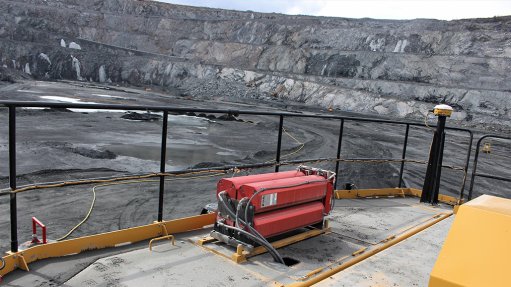
MINIMISING DOWN TIME A well-integrated fire suppression system minimises the risks of costly downtime that a fire can entail
Vehicle fire suppression system solutions provider Dafo Vehicle Fire Protection hosted a webinar last month to discuss the most common fire risk trends for heavy duty mining vehicles, as well as present recommendations and best practices to ensure that these risks are minimised or eliminated.
The information, presented by Dafo Vehicle global business manager for mining Marcello Sanchez and Dafo Vehicle fire protection research and development manager Anders Gulliksson, was collated using related research by the New South Wales (NSW) Division of Resources and Energy, Australia; US-based agency Mine Safety and Health Administration (MSHA) and professional service provider Svemin’s health and safety committee GRAMKO.
Surface and underground mining are complex operations that require heavy-duty mobile equipment (HDME) and processing equipment to operate continuously at remote locations.
In addition, these machines operate under challenging and demanding conditions in environments with many potential fire hazards, as HDMEs often carry flammable liquids in pressurised fuel lines close to hot engines and transmissions.
“When a fire breaks out on a mining vehicle, the results can be dramatic. Expensive repairs and/or the replacement of valuable equipment are the obvious consequences,” said Sanchez.
Extensive downtime and business interruption can result in even greater expenses, as this equipment often takes many months to repair or replace. Further, and most importantly, a fire on a mining vehicle can mean serious injuries to the machine operator and other employees, as well as leading to geological instability in some cases.
Meanwhile, according to data collected by the NSW Division of Resources and Energy, the top three causes of fires on mine vehicles from 2001 to 2008 were hose failure, accounting for about 25%, followed by poor maintenance (15%) and seal failure (about 11%).
Gulliksson added that it was important to note that hose and seal failure could be a result of poor maintenance.
Based on the data derived from MSHA, it was also noted that a large number of mining-equipment fires stem from ruptured hydraulic or fuel lines, and fittings or gaskets that fail, as well as electrical shorts in power cable systems.
Further, GRAMKO collected data from 1988 to 2010 that focused on the electrical parts involved in fires, with the research demonstrating that 88 fires were caused by vehicle cables, with Gulliksson reiterating cables’ susceptibility to wear and tear.
Sanchez pointed out that, in many cases, these failures could have been limited and/or avoided by scheduling more frequent and thorough inspections, adding that “potential system failures may be detected beforehand to prevent catastrophic scenarios”.
He added that any equipment deemed critical for an operation required good maintenance, and that the harshness of the environment was directly proportional to the importance of regular maintenance.
Consequently, insurance companies put regulations in place that focus on additional maintenance and instil checks for control points, especially hoses and pipes. They know from all the statistics available that a lack of maintenance is a huge fire hazard, Gulliksson commented.
Other contributing factors include hydraulic oil, engine oil, or coolant mist contacting hot engine areas; the build-up of combustible material, such as lubricants, fuels or rags, near to heat or ignition sources; and the ineffective isolation of ignition sources such as battery terminals.
Consequently, Dafo Vehicle recommended measures to eliminate or minimise the risk of fires breaking out on mobile equipment. These are regularly washing and/or cleaning equipment; adopting a risk-based hydraulic hose management system; systematically inspecting all components in hydraulic systems, including engine oil supply, fuel and coolant supply circuits during routine part replacements; and proactively monitoring hydraulic hoses, which must include checking connections, clamps and pressure relief valves.
Mining houses can also engage with manufacturers or authorised service providers to perform quality checks, in addition to regularly scheduled maintenance.
Other recommended steps include isolating potential engine heat sources and insulating hoses near hot components where possible, and routinely inspecting electrical systems for corrosion or insulation fatigue. Dafo Vehicle noted that, with the routine inspections, it is also important to consider the location and rating of protective devices such as fuses and wiring control.
The mining house can also install portable fire extinguishers on board all mobile equipment, as well as train all vehicle operators on fire hazards and fire detection, as well as procedures.
Sanchez explained that critical risk controls must be understood by all personnel and applied without exception to ensure everyone’s safety, while Gulliksson also noted the importance of installing and systematically inspecting fire-suppression systems.
Gulliksson concluded that if a mining house invested in a fire-suppression system for the mining vehicles, the system installed would only be as reliable as the maintenance and service performed.